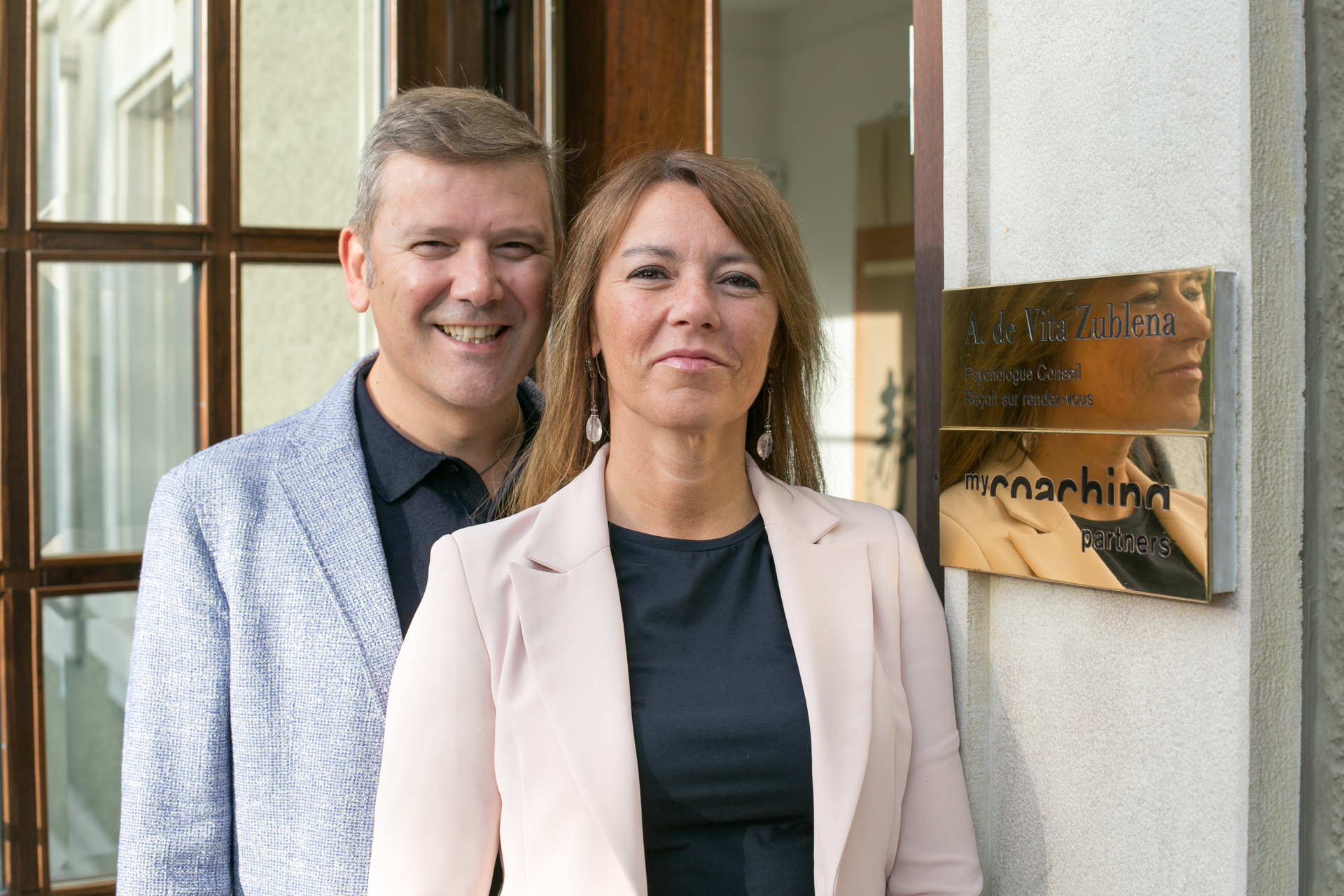The first step to become coach
Certified Practitioner in Neuro-Linguistic Programming (NLP) and NLP New Code in 12 days, signed by John Grinder, co-creator of NLP and co-developer of NLP New Code.
-
Practitioner in Nouveau code NLP in 9 days
-
Program New Code NLP
-
Practitioner in PNL and New code in 12 days
-
Program NLP and NLP New Code
Language: French
Target audience: Open to everyone*
Schedule: from 9am to 5pm, at my coaching partners sa Lausanne
N° of participants: 8 maximum on selection
Duration: 9 days + 1 day of certification
Price : 6’125.-- CHF for individuals and 7'800.-- CHF for companies
*Participants will be selected based on a pre-course questionnaire and an interview with the trainers.
A recognised certification
This Course, unique in Switzerland, offer you a certification as Practitioner in New Code NLP signed John Grinder (Co-Creator of NLP & Co-Creator of New Code NLP), Carmen Bostic St. Clair (Co-Creator of New Code NLP) and Michael Carroll (Co-Developer of New Code NLP), by Alessandro de Vita Zublena (Approved New Code Trainer & Certified member by ITCANLP), Federica De Nardi (Approved New Code Trainer & Certified member by ITCANLP).
Participants will be tested throughout the course through puzzles and games.
During certification, participants will take a practical exam and be tested on how they assimilate and use the New Code NLP protocols.
Next training sessions: Winter 2024
Our course program
What you will learn:
The Origin of Neuro-Linguistic Programming and the Development of the New Code of NLP
- What is NLP?
- NLP Story
- Distinction among NLP modeling, application and training
- Difference between the classic Code and the New Code of NLP
- The New Format for Change
- What is a model?
- What is a pattern?
NLP epistemology and logical levels
- How our experiences are created and maintained, how we know what we know: F1 transformations, First access, F2 transformations, Linguistic representations
- Ability to recognize the transformations of different points of representation and their impact on the mental process at different points of the representation
- Ability to design interventions and to understand the lever in the epistemological distinction
- Logical levels and types, as well as our classification of the world, according to John Grinder & Carmen Bostic St. Clair
Principes fondamentaux de la PNL
Rapport
- Build and maintain a relationship of trust through the mirror effect
- The visual and auditory mirror effect
- Visual and auditory mirroring
- “Micro-muscular” movement for non-verbal influence and a deeper level of relationship
- Alignment, including manipulation of representation systems
- Create empathy with others and with yourself
Calibration
- Ability to calibrate in each of the sensory input channels: visual, auditory and kinesthetic
- Ability to distinguish between conscious and unconscious signals in non-verbal communication
- Calibrate verbal and non-verbal behavior, sharpening the senses to detect and respond to unconscious signals from others
Representational systems
- Ability to detect the preferred system of representation in eye movements, predicates, voice quality
- Ability to quickly and smoothly adjust your verbal and non-verbal communication
- Overlapping systems to help others have more choice in how they view the world
- Identification and use of ordered sequences of representation systems
- Model of “synesthesia”
- Use of sub-modalities to improve clarity and focus
- Mapping of sub-modalities for behavioral choice
Language patters
- NLP communication tools to convey your message, understand others and be understood
- Differentiation of models in the Milton model
- Using models in the Milton model
- Presuppositions and their value for directing attention
Minimum metaphor competency
- Isomorphic / homomorphic mapping
- Naturalistic metaphors
- Metaphors using anchoring to specify to the unconscious of clients the elements of the metaphor that correspond to specific elements of the problem or challenge presented
- Living metaphors
Anchoring techniques
- Ability to establish and reactivate anchors in each of the three main input channels
- Use the anchor in change formats
- Spatial anchoring (circle of excellence)
Fundamental Principles of the NLP New Code
Chain of excellence
- Breathing – Physiology – State – Performance
- How to use it and when to use it
Multiple perceptual positions
- The concept of perceptual positions
- First position of perception, second position of perception, third position of perception
- Recognize and use the perception of self, of others and of the observer
- The importance of the “clean” 3rd position.
- How to “take some distance”, evaluate performance and discover new choices.
Language patterns
- The “Verbal package” specifying what you want
- Framing
- The two specific questions for nouns (who / what specifically?) and verbs (how specifically?)
- Paraphrase and mis-paraphrase to clarify the alignment of the person’s mind map
- Description, interpretation, evaluation
Intention and consequences model
- Misalignment
- Alignment
Choice of state
- Deepening of the Know Nothing State and its link with high performance
- The state as a vector of change
- Access high performance states through the New Change Format
Trigger point drills
- Use of trigger points with different choices (e.g. high performance state or 3rd position “clean”)
New Code High Performance Games
- Alphabet game
- NASA game
- Alphabet game by touch
- Croydon ball game
- Swiss ball game
New code: “state builders”
- Breath of life
- Rhythm of Life
- Peripheral vision drills
- Sanctuary
- Walk with X and Y
- Self-application of New Code protocols
Involuntary signals to partner with your unconscious
- New update of the classic Code reframing in 6 steps
- Arbitrary involuntary systems
- Use of involuntary natural signals
- The role of the unconscious in learning and change
- Create a communication channel with your unconscious
- Calibrate and work with the involuntary and unconscious signals of others
- Work with ‘unconscious intention’, calibrating and working with involuntary unconscious signals
- Recognize and use SOS (spontaneous occurring signal that occurs in the body) to create an alliance with your unconscious.
- Create a protective filter thanks to the unconscious
- Methods to help people dissociated by kinesthesia to develop signals
In summary:
Training: 181 hours
Residential: 72 hours
Self-study: 15 hours
One-on-one mentoring via Zoom: 2 hours
Group mentor via Zoom: 4 hours
Peer-to-peer coaching: 30 hours
Coaching with Clients: 30 hours
Self-coaching: 20 hours
Certification: 8 hours (1 day)
Language: French
Target audience: Open to everyone*
Schedule: from 9am to 5pm, at my coaching partners sa Lausanne
N° of participants: 8 maximum on selection
Duration: 12 days + 1 day of certification
Price : 8’750.-- CHF for individuals and 11'150.-- CHF for companies
*Participants will be selected based on a pre-course questionnaire and an interview with the trainers.
A recognised certification
This Course, unique in Switzerland, offer you a double certification as Practitioner in Classic Code NLP and Practitioner in New Code NLP signed John Grinder (Co-Creator of NLP & Co-Creator of New Code NLP), Carmen Bostic St. Clair (Co-Creator of New Code NLP) and Michael Carroll (Co-Developer of New Code NLP), by Alessandro de Vita Zublena (Approved New Code Trainer & Certified member by ITANLP), Federica De Nardi (Approved New Code Trainer & Certified member by ITANLP).
Participants will be tested throughout the course through puzzles and games.
During certification, participants will take a practical exam and be tested on how they assimilate and use the Classic code NLP and New Code NLP protocols.
Next training sessions: Winter 2024
Our course program
What you will learn:
The Origin of Neuro-Linguistic Programming and the Development of the New Code of NLP
What is NLP?
NLP Story
Distinction among NLP modeling, application and training
Difference between the classic Code and the New Code of NLP
The New Code Change Format
What is a model?
What is a pattern?
NLP epistemology and logical levels
How our experiences are created and maintained, how we know what we know: F1 transformations, First access, F2 transformations, Linguistic representations
Ability to recognize the transformations of different points of representation and their impact on the mental process at different points of the representation
Ability to design interventions and to understand the lever in the epistemological distinction
Logical levels and types, as well as our classification of the world, according to John Grinder & Carmen Bostic St. Clair (defined in Whispering in the Wind)
Fundamental Principles of the NLP (Classic code)
Rapport
Build and maintain a relationship of trust through the mirror effect
The visual and auditory mirror effect
“Micro-muscular” movement for non-verbal influence and a deeper level of relationship
Alignment, including manipulation of representation systems
Create empathy with others and with yourself
Calibration
Ability to calibrate in each of the sensory input channels: visual, auditory and kinesthetic
Ability to distinguish between conscious and unconscious signals in non-verbal communication
Calibrate verbal and non-verbal behavior, sharpening the senses to detect and respond to unconscious signals from others
Representational systems
Ability to detect the preferred system of representation in eye movements, predicates, voice quality
Ability to quickly and smoothly adjust your verbal and non-verbal communication
Overlapping systems to help others have more choice in how they view the world
Identification and use of ordered sequences of representation systems
Model of “synesthesia”
Use of sub-modalities to improve clarity and focus
Mapping of sub-modalities for behavioral choice: map across
Swish pattern
Language patters
NLP communication tools to convey your message, understand others and be understood
Meta model patterns
Differentiation of models in the Milton model
Using models in the Milton model in context of influence, simple hypnotic patterning
Presuppositions and their value for directing attention
Frank Farrelley’s provocation method
Minimum metaphor competency
Isomorphic / homomorphic mapping
Naturalistic metaphors
Metaphors using anchoring to specify to the unconscious of clients the elements of the metaphor that correspond to specific elements of the problem or challenge presented
Living metaphors
Anchoring techniques
Ability to establish and reactivate anchors in each of the three main input channels
Use the anchor in change formats
Spatial anchoring (circle of excellence)
Change personal history/re-imprinting
Collapse of anchors
Timeline interventions
Being able to set parallel tasks that are isomorphic to the client’s ‘present issue’ to create change in the client’s circumstances with the direct involvement of the client’s conscious mind
Part Interventions
Recognize parts as a metaphor
Negotiation between parts
Parts integration
Building a team
Fundamental Principles of the NLP New Code
Chain of excellence
Breathing – Physiology – State – Performance
How to use it and when to use it
Multiple perceptual positions
The concept of perceptual positions
First position of perception, second position of perception, third position of perception
Recognize and use the perception of self, of others and of the observer
The importance of the “clean” 3rd position.
How to “take some distance”, evaluate performance and discover new choices.
Language patters
The “Verbal package” specifying what you want
Framing
The two specific questions for nouns (who / what specifically?) and verbs (how specifically?)
Paraphrase and mis-paraphrase to clarify the alignment of the person’s mind map
Description, interpretation, evaluation
Intention and consequences model
Misalignment
Alignment
Choice of state
Deepening of the Know Nothing State and its link with high performance
The state as a vector of change
Access high performance states through the New Change Format
Trigger point drills
Use of trigger points with different choices (e.g. high performance state or 3rd position “clean”)
New Code Games
Alphabet game
NASA game
Alphabet game by touch
Croydon ball game
Swiss ball game
New code: “state builders”
Breath of life
Rhythm of Life
Peripheral vision drills
Sanctuary
Walk with X and Y
Self-application of New Code protocols
Involuntary signals to partner with your unconscious
New update of the classic Code reframing in 6 steps
Arbitrary involuntary systems
Use of involuntary natural signals
The role of the unconscious in learning and change
Create a communication channel with your unconscious
Calibrate and work with the involuntary and unconscious signals of others
Work with ‘unconscious intention’, calibrating and working with involuntary unconscious signals
Recognize and use SOS (spontaneous occurring signal that occurs in the body) to create an alliance with your unconscious.
Create a protective filter thanks to the unconscious
Methods to help people dissociated by kinesthesia to develop signals
In summary:
Training: 205 hours
Residential: 96 hours
Self-study: 15 hours
One-on-one mentoring via Zoom: 2 hours
Group mentor via Zoom: 4 hours
Peer-to-peer coaching: 30 hours
Coaching with Clients: 30 hours
Self-coaching: 20 hours
Certification: 8 hours (1 day)



